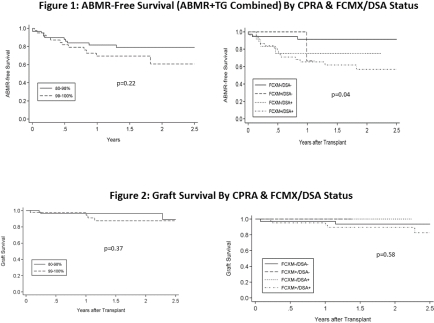Impact of the New KAS on Transplant Rates in Highly-HLA Sensitized (HS) Patients after Desenstization (DES): 3yrs Post Implementation
Kidney Transplant, Cedars-Sinai Medical Center, LA, CA.
Meeting: 2018 American Transplant Congress
Abstract number: 329
Keywords: B cells, Highly-sensitized, HLA antibodies, Kidney transplantation
Session Information
Session Name: Concurrent Session: Kidney Immunosuppression: Desensitization
Session Type: Concurrent Session
Date: Monday, June 4, 2018
Session Time: 4:30pm-6:00pm
 Presentation Time: 5:42pm-5:54pm
Presentation Time: 5:42pm-5:54pm
Location: Room 4B
Introduction: The KAS aims to increase equity in organ allocation for broadly sensitized (HS) patients, especially (CPRA 99-100%). Coupling desensitization (DES) + KAS likely will improve outcomes & reduce ABMR. Here we explore the effect of Y3 post-KAS on transplant rates and outcomes for DES patients receiving HLAi transplantation. Patients & Methods: Post KAS waitlisted HS patients (CPRA>80%) with CPRA points likely to receive transplants in 6M underwent DES with IVIG+rituximab ±PLEX ±Tocilizumab. Acceptable CMX criteria for transplantation included: Negative CDC, T&B-cell FCMX ≤225MCS and DSA ≤10,000MFI post-DES. Unacceptable antigens were defined as MFI>15,000. Patient & graft survival and freedom from ABMR were compared among transplanted patients with CPRA 80-98% and 99-100%. All transplanted HS patients received induction with alemtuzumab x1 & maintained with tac/mmf/pred. Results: From 12/4/14 to present, 100 HS patients {G1: 59 (CPRA 80-98%) & G2: 41 (CPRA 99-100%)} received transplants. Briefly, 6% {G1} vs. 15% {G2} received 0MM kidneys; CIT was 14.5±6hrs vs. 20.5±5hrs (p=0.0015); 47% vs. 44% were FCMX+/DSA+ @transplant (p=0.72); 63% vs. 80% had previous transplants (p=0.05). ABMR occurred in 11 (17%) in G1 vs. 12 (29%) in G2 (p=NS). Freedom from ABMR+TG did not differ by CPRA status (p=0.22); however, rejection was worse in FCMX+/DSA+ (p=0.04) (Fig 1). However, no differences in graft survival by CPRA or FCMX/DSA status were seen (p=NS) (Fig 2).  Conclusions: Rates of kidney transplantation among HS patients has decreased somewhat since KAS inception, although HS patients still benefit from broader access to deceased donor kidneys post-KAS. Despite broader access, HLA-incompatible transplants accounted for nearly half of all transplants performed in HS patients post-KAS. The rate of ABMR was as high as 29% in G1, primarily in 1st year post-transplant. Despite this, graft survival was excellent, demonstrating the importance of both desensitization & allocation policy in facilitating successful transplantation Post-KAS.
Conclusions: Rates of kidney transplantation among HS patients has decreased somewhat since KAS inception, although HS patients still benefit from broader access to deceased donor kidneys post-KAS. Despite broader access, HLA-incompatible transplants accounted for nearly half of all transplants performed in HS patients post-KAS. The rate of ABMR was as high as 29% in G1, primarily in 1st year post-transplant. Despite this, graft survival was excellent, demonstrating the importance of both desensitization & allocation policy in facilitating successful transplantation Post-KAS.
CITATION INFORMATION: Vo A., Huang E., Ammerman N., Williamson S., Myers C., Peng A., Najjar R., Sethi S., Lim K., Jordan S. Impact of the New KAS on Transplant Rates in Highly-HLA Sensitized (HS) Patients after Desenstization (DES): 3yrs Post Implementation Am J Transplant. 2017;17 (suppl 3).
To cite this abstract in AMA style:
Vo A, Huang E, Ammerman N, Williamson S, Myers C, Peng A, Najjar R, Sethi S, Lim K, Jordan S. Impact of the New KAS on Transplant Rates in Highly-HLA Sensitized (HS) Patients after Desenstization (DES): 3yrs Post Implementation [abstract]. https://atcmeetingabstracts.com/abstract/impact-of-the-new-kas-on-transplant-rates-in-highly-hla-sensitized-hs-patients-after-desenstization-des-3yrs-post-implementation/. Accessed December 20, 2025.« Back to 2018 American Transplant Congress
